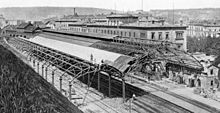Steel construction Hilgers
The Hilgers company in Rheinbrohl emerged from the locksmith's shop in Lennep founded by Jacob Hilgers (born October 3, 1834 in Solingen ; † November 19, 1880 in Rheinbrohl) .
history
In the first few years Jacob Hilgers manufactured not only door closers but also household appliances in his locksmith's shop in Lennep. During a trip to the Rhine, he discovered the Abbey Estate Die Maas, which was for sale, in Rheinbrohl and acquired it on February 20, 1867. Two years later he had the first new building built and opened the first galvanizing plant in Germany. After the war of 1870/71 the galvanizing plant was enlarged and galvanized flat and corrugated sheets were produced. Hilgers designed the machines required for this himself. The train stations in Metz , Magdeburg and the largest hall in Europe, the Anhalter Bahnhof in Berlin , were covered with corrugated iron. From 1873 pioneer pontoons and collapsible corrugated iron huts were made for the military. Later on, hunting lodges , railway keeper's houses, production halls and public toilets were developed from this.
After Jacob Hilgers' death in 1880, the widow continued to run the company and tried to expand. On August 6, 1888, after negotiations with the Oppenheim bank, the stock corporation for galvanizing and iron construction, formerly Jakob Hilgers, Rheinbrohl was founded. In 1898 Hilgers took a stake in the Russian company Karl Bechthold in Jekaterinoslaw, which they parted with in 1904 due to ongoing losses.
In 1906 a 5200 m² hall was built on the Hilgers AG site and the machinery was modernized. The rail connection made in 1905 meant that the structural parts could be loaded directly onto the railroad. By 1910 factories had already been built in Mannheim , Stuttgart , Darmstadt , Cologne , Amsterdam and Strasbourg . An aircraft hangar was built for Fokker at Schiphol Airport .
In 1921 the Moguntia stamping and enamelling factory in Mainz-Kostheim was taken over, but sold again the following year. On May 19, 1927, the name was changed to Hilgers Aktiengesellschaft. During the global economic crisis from 1929 onwards, the so-called Grümper system was introduced at Hilgers. This meant that the workers worked three months each and were registered as unemployed for three months, the office staff only worked four hours a day on half the salary. From 1934 the order situation improved again and the factory was further expanded. In 1939 the export share was 20 percent of total sales. In the war years from 1939 to 1945, full employment prevailed despite the difficulties caused by the war; in December 1941 the company had 1,274 employees. American troops occupied the plant on March 19, 1945. As early as the second half of 1945, work was resumed and destroyed steel bridges repaired and sunk ships in the Rhine lifted and repaired.
Hilgers shipyard
Iron building and bridge construction
The bridge construction department was established in the 1890s. The first larger bridge was the Kothener Bridge near Elberfeld over the Wupper. With the expansion of the German railway network, the number of railway bridges built by Hilgers also increased. In 1911, the Neuwied company, Actiengesellschaft für Brückenbau, Tiefbau und Eisenkonstruction , was taken over, and the bridge construction department was expanded and the first bridges were built in South America and Indochina. Over 100 bridges have been built in Indochina alone, and over 50 in South America.
Another branch of the company was the crane construction department, which mainly produced construction cranes and hall cranes . With the introduction of prestressed concrete construction for bridges, Hilgers also built telescopic towers for many bridges.
In the mast construction department, masts for high voltage lines made of steel and aluminum as well as transmission masts were built.
The Neuwied plant was closed in June 1978 and the shipyard was closed in 1985. One year after the company's 125th anniversary in 1992, DSD Dillinger Stahlbau GmbH became the main shareholder of Hilgers AG. On April 1, 1994, the galvanizing plant was sold to the Wiegels company. In 2003 Hilgers AG and DSD merged to form DSD Stahlbau GmbH, Hilgers AG branch, and in 2004 DSD Hilgers Stahlbau was founded. The Rheinbrohl location was retained.
literature
- 100 years Hilgers Rheinbrohl and Neuwied, anniversary book for the 100th anniversary of Hilgers AG, publisher: Hilgers AG 1967





